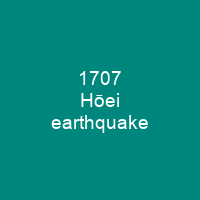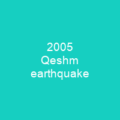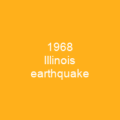The 1707 Hōei earthquake struck south-central Japan at 14: 00 local time on 28 October. It was the largest earthquake in Japanese history until surpassed by the 2011 Tōhoku earthquake. The earthquake caused more than 5,000 casualties, destroyed 29,000 houses, and triggered at least one major landslide.
About 1707 Hōei earthquake in brief

The event ruptured all of the segments of the Nankai megathrust simultaneously, the only earthquake known to have done this. It might also have triggered the last eruption of Mount Fuji 49 days later.
You want to know more about 1707 Hōei earthquake?
This page is based on the article 1707 Hōei earthquake published in Wikipedia (as of Oct. 29, 2020) and was automatically summarized using artificial intelligence.







